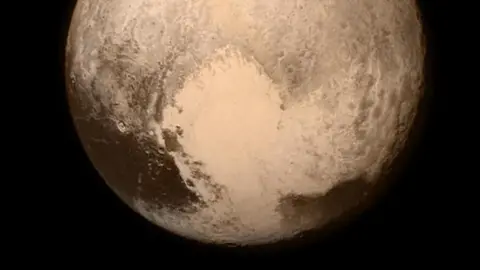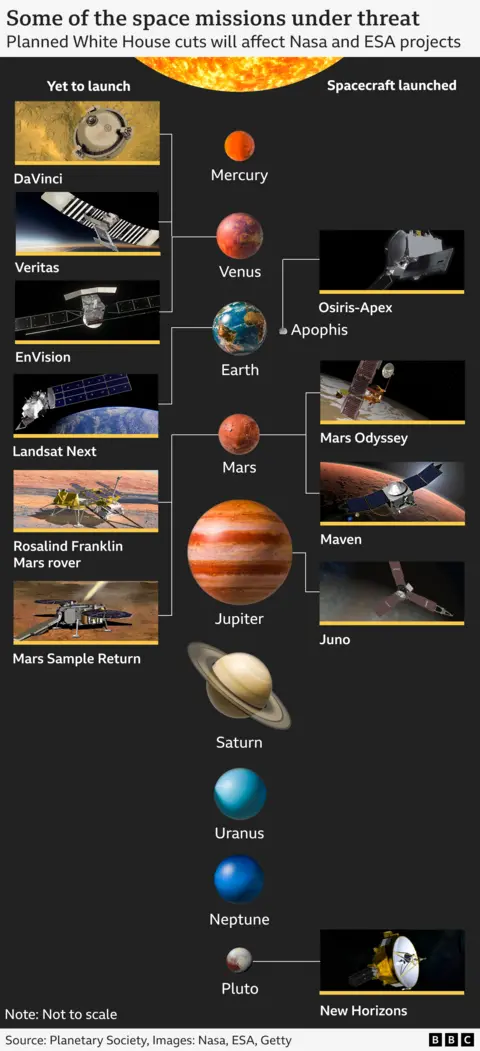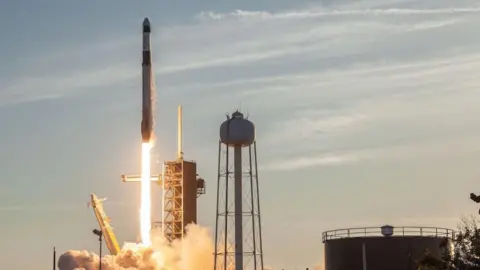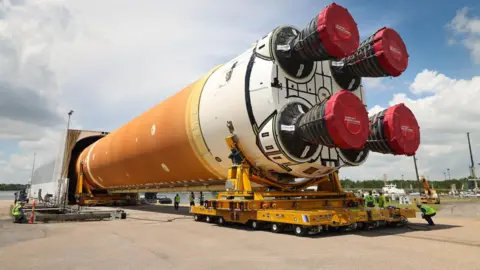/ Jun 08, 2025
Trending

Science correspondent

 NASA/Johns Hopkins
NASA/Johns HopkinsThe row between Donald Trump and Elon Musk over a major spending bill has exacerbated uncertainty over the future of Nasa’s budget, which is facing deep cuts.
The space agency has published its budget request to Congress, which would see funding for science projects cut by nearly a half.
Forty science missions, which are in development or in space already, are in line to be stood down.
The president has threatened to withdraw federal contracts with Musk’s company, Space X. Nasa relies on the firm’s Falcon 9 rocket fleet to resupply the International Space Station with crew and supplies. The space agency also expects to use its Starship rocket to send astronauts to the Moon and eventually to Mars once it has been developed.
Dr Simeon Barber, a space scientist at the Open University said that the uncertainty was having a “chilling impact” on the human space programme.
“The astonishing exchanges, snap decisions and U turns we’ve witnessed in the last week undermine the very foundations that we build our ambitions on.
“Space science and exploration relies upon long term planning and cooperation between government, companies and academic institutions.”

 BBC News
BBC NewsAside from the feud between the President and Mr Musk, there is also concern about deep cuts requested by the White House to Nasa’s budget.
All sectors have been earmarked for savings, apart from an effort to send astronauts to Mars, which has received a $100m (£736,000) boost.
According to Casey Dreier, chief of space policy for the Pasadena-based Planetary Society, which promotes space exploration, the potential cuts represent “the biggest crisis ever to face the US space programme”.
Nasa has said that its request to reduce its overall budget by nearly a quarter “aligns (its) science and technology portfolios to missions essential for the exploration of the Moon and Mars”.
Dr Adam Baker, a space analyst at Cranfield University told BBC News that if these proposals are approved by Congress, it would fundamentally shift the agency’s focus.
“President Trump is repurposing Nasa for two things: to land astronauts on the Moon before the Chinese and to have astronauts plant a US flag on Mars. Everything else is secondary.”

 NASA
NASAThose who back the proposals say the White House’s budget has given Nasa a clear purpose, for the first time since the days of the Apollo Moon landings of the 1960s and 70s, when the aim was to beat the Soviet Union to the Moon. Nasa’s critics say that since then the space agency has become a bloated, unfocussed bureaucracy which routinely goes massively over budget in its space missions and wastes taxpayer’s money.
One of the most egregious examples of this is Nasa’s new rocket for its plans to return American astronauts to the Moon, the Space Launch System (SLS). Its development has been delayed, and costs have spiralled such that it costs $4.1bn (£3.3bn) for each and every launch. By contrast, SpaceX’s equivalent rocket system, Starship, is estimated to cost around $100m (£80m) per launch because it is designed to be reusable. Jeff Bezos’s Blue Origin space company promises similar savings for its proposed New Glenn rocket.
To no one’s surprise, SLS will be phased out under the White House proposals, in the hope that Starship and New Glenn can take its place. But the past three development launches of Starship have been unsuccessful, and Blue Origin has only recently begun to test its Moon rocket.
“The worry is that Nasa may be jumping out of the frying pan, into the fire,” says Dr Barber.
“The development of these alternatives to SLS is being bankrolled by Elon Musk and Jeff Bezos.
“If they lose their appetite for this endeavor and SpaceX or Blue Origin say they need more money to develop their systems, Congress will have to give it to them,” says Dr Barber.
Of greater concern, says Dr Barber, is the potential loss of 40 missions to explore other planets and to monitor the impact of climate change on Earth from space, many of which involve collaborations with international partners.
“I think it is very sad that what has taken so long to build can be knocked down with a wrecking ball so quickly with no plan to rebuild it afterwards.”
The projects facing the axe include dozens of planetary missions already in space for which most of the development and launch costs have already been paid for, with relatively small savings proposed on their operating costs.

 Getty Images
Getty ImagesAlso under threat are two collaborations with the European Space Agency: An ambitious plan to bring martian rocks collected by Nasa’s Perseverance Rover back to Earth and a mission to send Europe’s Rosalind Franklin Rover to the red planet to search for signs of past life.
Prof Sir Martin Sweeting, head of the UK space firm Surrey Satellite Technology Ltd, and co-author of a Royal Society report on the future of space says that while the development was “unwelcome”, there may be an upside for Europe as it takes greater responsibility for its own space exploration programme.
“Maybe we have been too reliant on Nasa the big player to carry a lot of the emphasis in space,” he told BBC News.
“It is an opportunity to think about how Europe wants to get a better balance in its space activities.”
But there is much more downside for Europe in the short term. As well as the return of Mars samples and its Rover, ESA risks reduced access to the International Space Station if it is wound down, and the budget cuts cancel Nasa’s extensive contributions to its successor, the Lunar Gateway, a multinational space station planned for orbit around the Moon.

 NASA
NASAIn its recently published strategy ESA stated it “will be seeking to build a more autonomous space capability, and to continue being a reliable, strong and desirable partner with space agencies from around the globe,” with the implication that it would do so with or without Nasa.
Also facing cuts are numerous current and proposed Earth Observation programmes according to Dr Baker.
“These Earth observation programmes are our canary in the coal mine,” he told BBC News.
“Our ability to predict the impact of climate change and mitigate against it could be drastically reduced. If we turn off this early warning system it is a frightening prospect”.
The budget proposals have yet to be approved by Congress. The planetary Society’s Casey Dreier has told BBC News that many Republicans have told lobbyists privately that they are prepared to vote against the cuts.
But, Mr Dreier worries that there is a strong possibility that political gridlock might mean that no budget will be agreed. It is likely that the reduced White House budget would be put in place as an interim measure, which could then not easily be reversed, because once space missions are turned off it is hard, if not impossible, to start them up again.
Science correspondent

 NASA/Johns Hopkins
NASA/Johns HopkinsThe row between Donald Trump and Elon Musk over a major spending bill has exacerbated uncertainty over the future of Nasa’s budget, which is facing deep cuts.
The space agency has published its budget request to Congress, which would see funding for science projects cut by nearly a half.
Forty science missions, which are in development or in space already, are in line to be stood down.
The president has threatened to withdraw federal contracts with Musk’s company, Space X. Nasa relies on the firm’s Falcon 9 rocket fleet to resupply the International Space Station with crew and supplies. The space agency also expects to use its Starship rocket to send astronauts to the Moon and eventually to Mars once it has been developed.
Dr Simeon Barber, a space scientist at the Open University said that the uncertainty was having a “chilling impact” on the human space programme.
“The astonishing exchanges, snap decisions and U turns we’ve witnessed in the last week undermine the very foundations that we build our ambitions on.
“Space science and exploration relies upon long term planning and cooperation between government, companies and academic institutions.”

 BBC News
BBC NewsAside from the feud between the President and Mr Musk, there is also concern about deep cuts requested by the White House to Nasa’s budget.
All sectors have been earmarked for savings, apart from an effort to send astronauts to Mars, which has received a $100m (£736,000) boost.
According to Casey Dreier, chief of space policy for the Pasadena-based Planetary Society, which promotes space exploration, the potential cuts represent “the biggest crisis ever to face the US space programme”.
Nasa has said that its request to reduce its overall budget by nearly a quarter “aligns (its) science and technology portfolios to missions essential for the exploration of the Moon and Mars”.
Dr Adam Baker, a space analyst at Cranfield University told BBC News that if these proposals are approved by Congress, it would fundamentally shift the agency’s focus.
“President Trump is repurposing Nasa for two things: to land astronauts on the Moon before the Chinese and to have astronauts plant a US flag on Mars. Everything else is secondary.”

 NASA
NASAThose who back the proposals say the White House’s budget has given Nasa a clear purpose, for the first time since the days of the Apollo Moon landings of the 1960s and 70s, when the aim was to beat the Soviet Union to the Moon. Nasa’s critics say that since then the space agency has become a bloated, unfocussed bureaucracy which routinely goes massively over budget in its space missions and wastes taxpayer’s money.
One of the most egregious examples of this is Nasa’s new rocket for its plans to return American astronauts to the Moon, the Space Launch System (SLS). Its development has been delayed, and costs have spiralled such that it costs $4.1bn (£3.3bn) for each and every launch. By contrast, SpaceX’s equivalent rocket system, Starship, is estimated to cost around $100m (£80m) per launch because it is designed to be reusable. Jeff Bezos’s Blue Origin space company promises similar savings for its proposed New Glenn rocket.
To no one’s surprise, SLS will be phased out under the White House proposals, in the hope that Starship and New Glenn can take its place. But the past three development launches of Starship have been unsuccessful, and Blue Origin has only recently begun to test its Moon rocket.
“The worry is that Nasa may be jumping out of the frying pan, into the fire,” says Dr Barber.
“The development of these alternatives to SLS is being bankrolled by Elon Musk and Jeff Bezos.
“If they lose their appetite for this endeavor and SpaceX or Blue Origin say they need more money to develop their systems, Congress will have to give it to them,” says Dr Barber.
Of greater concern, says Dr Barber, is the potential loss of 40 missions to explore other planets and to monitor the impact of climate change on Earth from space, many of which involve collaborations with international partners.
“I think it is very sad that what has taken so long to build can be knocked down with a wrecking ball so quickly with no plan to rebuild it afterwards.”
The projects facing the axe include dozens of planetary missions already in space for which most of the development and launch costs have already been paid for, with relatively small savings proposed on their operating costs.

 Getty Images
Getty ImagesAlso under threat are two collaborations with the European Space Agency: An ambitious plan to bring martian rocks collected by Nasa’s Perseverance Rover back to Earth and a mission to send Europe’s Rosalind Franklin Rover to the red planet to search for signs of past life.
Prof Sir Martin Sweeting, head of the UK space firm Surrey Satellite Technology Ltd, and co-author of a Royal Society report on the future of space says that while the development was “unwelcome”, there may be an upside for Europe as it takes greater responsibility for its own space exploration programme.
“Maybe we have been too reliant on Nasa the big player to carry a lot of the emphasis in space,” he told BBC News.
“It is an opportunity to think about how Europe wants to get a better balance in its space activities.”
But there is much more downside for Europe in the short term. As well as the return of Mars samples and its Rover, ESA risks reduced access to the International Space Station if it is wound down, and the budget cuts cancel Nasa’s extensive contributions to its successor, the Lunar Gateway, a multinational space station planned for orbit around the Moon.

 NASA
NASAIn its recently published strategy ESA stated it “will be seeking to build a more autonomous space capability, and to continue being a reliable, strong and desirable partner with space agencies from around the globe,” with the implication that it would do so with or without Nasa.
Also facing cuts are numerous current and proposed Earth Observation programmes according to Dr Baker.
“These Earth observation programmes are our canary in the coal mine,” he told BBC News.
“Our ability to predict the impact of climate change and mitigate against it could be drastically reduced. If we turn off this early warning system it is a frightening prospect”.
The budget proposals have yet to be approved by Congress. The planetary Society’s Casey Dreier has told BBC News that many Republicans have told lobbyists privately that they are prepared to vote against the cuts.
But, Mr Dreier worries that there is a strong possibility that political gridlock might mean that no budget will be agreed. It is likely that the reduced White House budget would be put in place as an interim measure, which could then not easily be reversed, because once space missions are turned off it is hard, if not impossible, to start them up again.
It is a long established fact that a reader will be distracted by the readable content of a page when looking at its layout. The point of using Lorem Ipsum is that it has a more-or-less normal distribution
The Us Media 2025